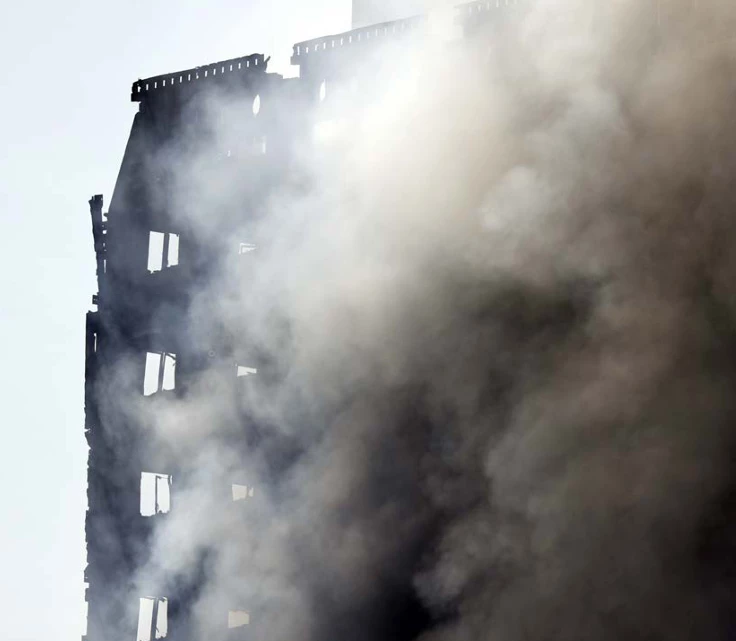The London Towering inferno
The fire which destroyed Grenfell Tower in June 2017 was one of the UK's worst modern disasters. 5 years later, we look back on this event with a republication of the article from FPC Risk's Trends magazine from 2018.
The night greed turned into heat
71 human lives brutally ended that night on the 14th of June, because a fridge caught fire in a 24-store tower flat. And because penny-pinching contractors valued their wallets above the safety of hundreds of innocent people. And because mistakes were made. A lot of mistakes. The Grenfell Tower drama sparked tremendous outrage, not only in Britain but around the globe.

In the night of June 14th about an hour after midnight a Hotpoint FF175BP fridge-freezer combi caught fire in a tower flat apartment in London city. It was on the fourth floor and it triggered a deadly chain of events. The flames spread like wildfire and by the time the fire brigade arrived at the scene, the blaze was infernal. The building lit up like a torch. 65 people were rescued from the building by fire f ighters. A lot of the residents fled higher up the building to escape the flames, only to become trapped in flats on the upper floors. 21 people died on the very top floor of the burning tower block. The inferno was not brought under control until 24 hours later. 71 people died in the flames that night.

An accident waiting to happen
The 68 meter Grenfell tower with its 24 floors was built in 1974. In 2015-16 it was completely renovated and provided with new windows and isolation. Even during the renovation works, safety didn’t seem to be much of a priority (e.g. there was only one usable entrance) and people were worried. There had been several power failures (for years) and a lot of the fire safety tools/devices were no longer supervised nor controlled, and even declared unfit. Fire safety instructions for the inhabitants were nowhere to be found, and according to the inhabitants there was no integrated fire alarm system installed at all. The only way out is a single set of concrete steps bisecting the building through its core. It is the only fire escape route for a block of hundreds of people. Those on the top three floors are looking at 22, 23, 24 flights of stairs. The same stairs fire fighters have to use to make their way up.
But the stairwell cavity also funnels fumes up inside the block and fills it with acrid smoke from the fire below - black, thick, poisonous. This smoke is causing choking and asphyxiation, but also nausea and confusion. For the older and less mobile people on the higher floors the place turned out to be a death trap, no less.
Stay inside and lock the door
An action committee of concerned inhabitants repeatedly sounded the alarm bells about fire safety problems to the KCTMO (Kensington en Chelsea Tenant Management Organisation) and bluntly accused it of criminal negligence. But it turned out to be a dialogue of the deaf. However, after extended pleas, fire instructions were issued in the building, stating people should lock themselves inside their apartments, until they were instructed otherwise by the fire brigades. “Your new front doors will withstand any fire for more than 30 minutes, which will give the fire brigades more than enough time” the KCTMO told the inhabitants in March 2017. London mayor Sadiq Khan was outraged: “Fortunately most inhabitants ignored this advice and fled anyway. The fire on that fatal night lasted more than 24 hours, and fire fighters never even reached the top floors…”

Killer cladding
Although the new facade covering didn’t cause the blaze, it actually was the reason the fire spread in next to no time all over the building and got people trapped in their homes. The flames got under the cladding mounted on wooden strips which burned like matches. The construction literally worked as a chimney, fanning and spreading the fire at lightning speed all over the building. Moreover the cladding was made with Reynobond PE – made of Reynolux-coated aluminium sheets over a highly flammable Reynobond polyethylene core. Dr Roth Phylaktou, an expert in fire investigation, said: “The polyethylene in the cladding would have burnt as quickly as petrol.” KCTMO as well as the local authorities are said to have put the squeeze on the contractors to go for the cheapest renovation of the council estates. They got what they asked for. The use of this type of cladding yielded a saving of about £ 300 000 (€ 340 979) in comparison to a (safe) zinc cladding.
Our stand
Technical
- Provide a reliable fire detection and alarm system and at least 2 compartimented fire exit staircases.
- Consider sprinklering and/or improve fire brigade intervention tactics and material.
- Remove combustible cladding and improve inspection on installation of isolation material.
Organisational
- Fix up specific awaraness campagnes in social housing blocks so people always know what to do in cases of emergency.
- Enforce and conduct thorough yearly fire inspections.
- Develop and implement fire risk based screening methods for social housing.
The question might rise whether these measures are economically feasible... But these same measures are implemented in residential buildings, so unless the lives of people living in social housing blocks are worth less than those who are a little more fortunate, the answer should be affirmative.
FPC Risk Trends n°28 - 2018
